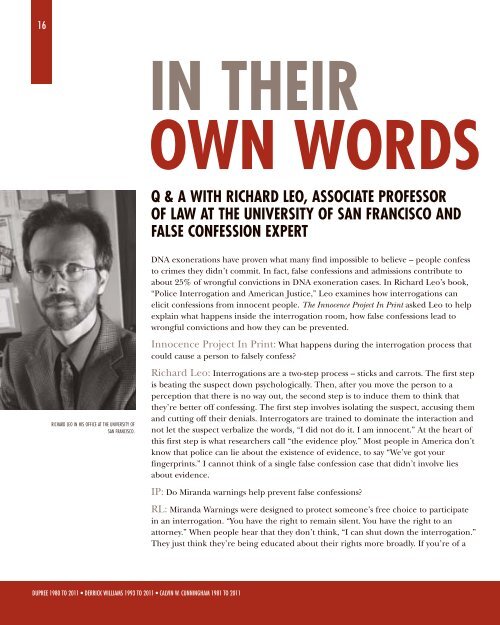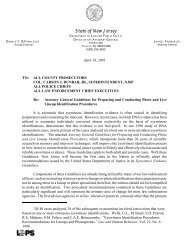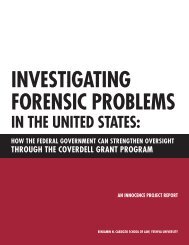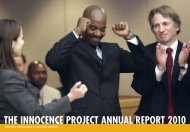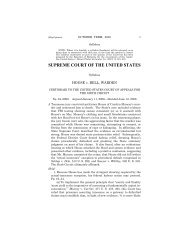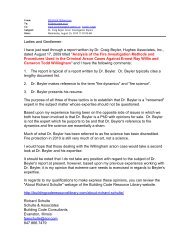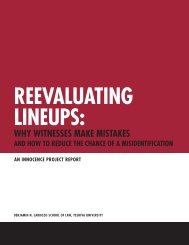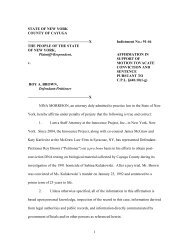16IN THEIROWN WORDSQ & A WITH RICHARD LEO, ASSOCIATE PROFESSOROF LAW AT THE UNIVERSITY OF SAN FRANCISCO ANDFALSE CONFESSION EXPERTDNA exonerations have proven what many f<strong>in</strong>d impossible to believe – people confessto crimes they didn’t commit. In fact, false confessions and admissions contribute toabout 25% of wrongful convictions <strong>in</strong> DNA exoneration cases. In Richard Leo’s book,“Police Interrogation and American Justice,” Leo exam<strong>in</strong>es how <strong>in</strong>terrogations canelicit confessions from <strong>in</strong>nocent people. <strong>The</strong> <strong>Innocence</strong> <strong>Project</strong> In Pr<strong>in</strong>t asked Leo to helpexpla<strong>in</strong> what happens <strong>in</strong>side the <strong>in</strong>terrogation room, how false confessions lead towrongful convictions and how they can be prevented.<strong>Innocence</strong> <strong>Project</strong> In Pr<strong>in</strong>t: What happens dur<strong>in</strong>g the <strong>in</strong>terrogation process thatcould cause a person to falsely confess?RICHARD LEO IN HIS OFFICE AT THE UNIVERSITY OFSAN FRANCISCO.Richard Leo: Interrogations are a two-step process – sticks and carrots. <strong>The</strong> first stepis beat<strong>in</strong>g the suspect down psychologically. <strong>The</strong>n, after you move the person to aperception that there is no way out, the second step is to <strong>in</strong>duce them to th<strong>in</strong>k thatthey’re better off confess<strong>in</strong>g. <strong>The</strong> first step <strong>in</strong>volves isolat<strong>in</strong>g the suspect, accus<strong>in</strong>g themand cutt<strong>in</strong>g off their denials. Interrogators are tra<strong>in</strong>ed to dom<strong>in</strong>ate the <strong>in</strong>teraction andnot let the suspect verbalize the words, “I did not do it. I am <strong>in</strong>nocent.” At the heart ofthis first step is what researchers call “the evidence ploy.” Most people <strong>in</strong> America don’tknow that police can lie about the existence of evidence, to say “We’ve got yourf<strong>in</strong>gerpr<strong>in</strong>ts.” I cannot th<strong>in</strong>k of a s<strong>in</strong>gle false confession case that didn’t <strong>in</strong>volve liesabout evidence.IP: Do Miranda warn<strong>in</strong>gs help prevent false confessions?RL: Miranda Warn<strong>in</strong>gs were designed to protect someone’s free choice to participate<strong>in</strong> an <strong>in</strong>terrogation. “You have the right to rema<strong>in</strong> silent. You have the right to anattorney.” When people hear that they don’t th<strong>in</strong>k, “I can shut down the <strong>in</strong>terrogation.”<strong>The</strong>y just th<strong>in</strong>k they’re be<strong>in</strong>g educated about their rights more broadly. If you’re of aDUPREE 1980 TO <strong>2011</strong> • DERRICK WILLIAMS 1993 TO <strong>2011</strong> • CALVIN W. CUNNINGHAM 1981 TO <strong>2011</strong>
IN THEIR OWN WORDS17certa<strong>in</strong> education level or have lawyers <strong>in</strong> the family, you might know that police cantrap you. But most people don’t know that. <strong>The</strong> impulse to talk when a police officer isaccus<strong>in</strong>g you is strong. We want to <strong>in</strong>st<strong>in</strong>ctively defend ourselves aga<strong>in</strong>st false accusations.You could say “I would like to have a lawyer.” In theory, that should end the <strong>in</strong>terrogation.Very few suspects actually say that, and usually when they have said that <strong>in</strong> the<strong>in</strong>nocence cases, it was ignored.IP: Can you speak about how young people are especially vulnerable?RL: <strong>The</strong>re’s great research from developmental psychology about why juveniles aremore vulnerable to false confessions: they’re less mature, they’re more impulsive, theyare more gullible and trustworthy, and they don’t th<strong>in</strong>k about long-term consequences.<strong>The</strong>se are the same reasons why people with low IQs are vulnerable. But falseconfessors are not limited to these categories.IP: Can hav<strong>in</strong>g the parents present dur<strong>in</strong>g an <strong>in</strong>terrogation be a protection?RL: I’ve always been skeptical about the idea of gett<strong>in</strong>g a guardian or parent <strong>in</strong> theroom. Because the police make up evidence, and they tell the parents, “We have peoplesay<strong>in</strong>g he did this.” <strong>The</strong>n the parents are like, “Joe, stop ly<strong>in</strong>g. You need to tell theofficer the truth.” So the parents become agents, oftentimes, of the police. Most parentsjust aren’t street smart.IP: Can you expla<strong>in</strong> the <strong>in</strong>vestigators’ “presumption of guilt”?RL: A police <strong>in</strong>terrogator’s goal is to build a case, not to separate out whether thesuspect is likely <strong>in</strong>nocent or likely guilty. <strong>The</strong>re’s no hypothesis test<strong>in</strong>g <strong>in</strong> <strong>in</strong>terrogations.If we start th<strong>in</strong>k<strong>in</strong>g about more thorough ways to analyze whether the suspect is likelyguilty or not, and maybe gett<strong>in</strong>g more evidence before we subject them to that<strong>in</strong>terrogation, maybe police can prevent more false confessions.“INTERROGATORS ARE TRAINEDTO DOMINATE THE INTERACTIONAND NOT LET THE SUSPECTVERBALIZE THE WORDS,‘I DID NOT DO IT.’”– Richard LeoIP: What other reforms do you recommend?RL: Electronically record<strong>in</strong>g the entire <strong>in</strong>terrogation is the most important reform.Non-public details (that are not publicly known by anyone other than the trueperpetrator and the police) can be <strong>in</strong>tentionally or un<strong>in</strong>tentionally imputed to thesuspect. <strong>The</strong>y make the confession seem persuasive. Record<strong>in</strong>g captures thecontam<strong>in</strong>ation process from start to f<strong>in</strong>ish. If a case were to go to trial, the defenseattorney can show how the details never were known by the person be<strong>in</strong>g accused,and how they were fed at every step of the way.IP: Are <strong>in</strong>terrogations ever good and necessary?RL: You need confessions to solve crimes, especially murder crimes, and as long asconfessions are done fairly and legally, we’re absolutely <strong>in</strong> favor of the <strong>in</strong>terrogationsthat produce them. We don’t want to underm<strong>in</strong>e the ability of police, most of whomare good and decent people who follow the rules, to get these confessions. As long asyou do th<strong>in</strong>gs fairly and properly, it shouldn’t endanger the <strong>in</strong>nocent.


